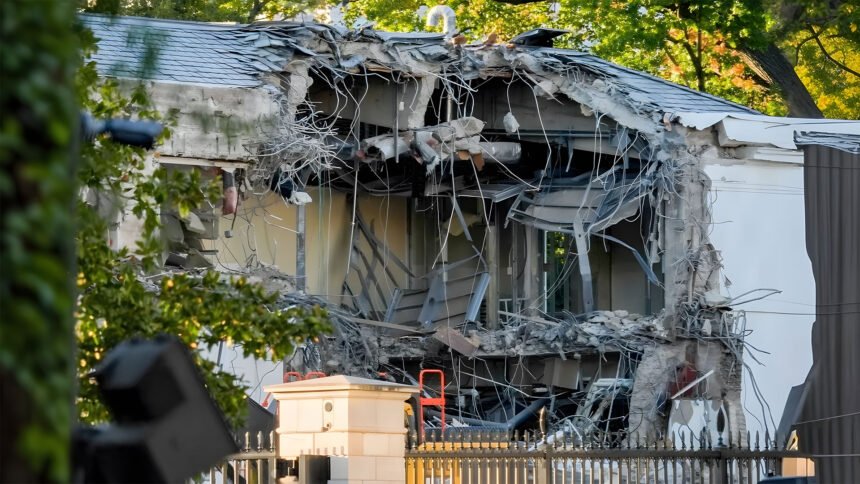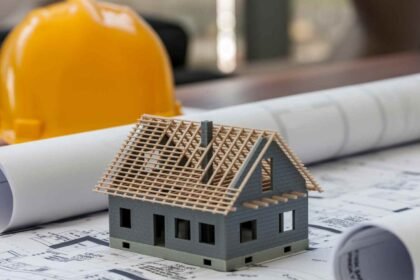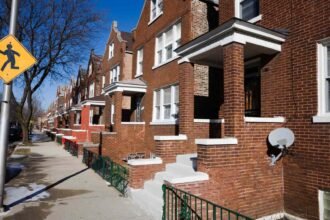WASHINGTON, D.C. — Demolition of the White House East Wing is well underway this week as part of a sweeping construction effort led by President Donald Trump to build a $250 million ballroom on the historic grounds. The project constitutes one of the most extensive physical changes to the Executive Mansion since President Harry Truman’s major renovation in 1948.
On Monday, crews began tearing down significant portions of the East Wing, which traditionally houses offices for the first lady and several key White House staff members. Construction vehicles and heavy machinery were seen entering and exiting the site throughout the week, while a seven-foot fence now surrounds the area to obscure demolition work from the public.
A White House official confirmed that the entire East Wing will be “modernized” as part of the project. “We can verify that the whole East Wing is set to be updated and refurbished,” the spokesperson said on Wednesday, adding that the demolition is expected to finish within two weeks.
The Project and Its Origins
President Trump first announced the ballroom in July 2025, describing it as a privately funded addition intended to enhance the White House’s capacity for hosting formal gatherings. The planned structure will span 90,000 square feet and accommodate up to 999 guests — more than four times the occupancy of the East Room, the mansion’s largest existing event space.
The ballroom project, which the president has touted as “beautiful” and “world-class,” is being financed entirely through private donations from American companies and individual contributors. According to reports, one notable source of funding includes a $22 million settlement payment from YouTube, part of a 2021 lawsuit involving Trump and the platform.
Trump emphasized that taxpayers will not bear the costs. “Numerous generous Patriots, Great American Companies, and myself are covering every dollar of it,” he stated in a post shared earlier this week.
Scope of Demolition
While Trump initially said no existing White House structures would be removed, the ongoing work shows a broader scope than his original description. “In order to do it properly, we had to take down the existing structure,” Trump explained to reporters on Wednesday inside the Oval Office.
Photographs published by multiple outlets show excavators breaking through the East Wing façade and clearing debris from the site. According to sources familiar with the development, roughly half of the building has already been brought down, including offices previously used by the first lady’s staff, military aides, and the White House calligrapher.
Questions Over Oversight
The project has sparked discussion over procedural approvals and regulatory oversight. Under ordinary circumstances, large-scale structural changes to the White House complex fall under the review of the National Capital Planning Commission (NCPC), a federal agency that governs major building projects in Washington, D.C. However, the NCPC has not approved the ballroom construction, and its offices remain closed amid an ongoing government shutdown.
Will Scharf, the NCPC’s chairman and a senior aide to Trump, said during a September meeting that the agency “does not oversee demolition or site preparation activities on federal properties.” This clarification effectively allowed the work to proceed without the commission’s explicit authorization.
The White House has stated its intention to present construction plans to the NCPC “at a later stage,” though officials insist no laws are being violated. Preservation groups, however, have expressed concern over the loss of one of the mansion’s historic sections and are calling for an immediate review of the project.
Historical and Structural Significance
The East Wing, added in 1902 under President Theodore Roosevelt and later expanded during Franklin D. Roosevelt’s administration in 1942, contains offices and function rooms frequently used for events hosted by the first lady. It also provides access to the underground presidential bunker constructed during World War II.
Architectural historians note that the East Wing holds symbolic value as part of the White House’s broader design integrity. Its demolition marks the first substantial change to the presidential residence in nearly eight decades. “This is the most consequential physical alteration to the property since Truman rebuilt the interior in the late 1940s,” one historian told Reuters.
On-Site Activity and Security Measures
Crews working on-site have been observed under tight security, with trucks screened upon entry and a reinforced perimeter established around the work area. Federal workers in nearby buildings, including the Treasury Department, have been advised not to photograph or record any construction activity visible from their offices.
By midweek, large chunks of concrete and debris were visible around the site’s perimeter. Some sections of the East Wing’s internal framework had already been removed, leaving open-air views into what previously housed government offices.
Official Response
During an Oval Office event on Wednesday, Trump acknowledged the public attention surrounding the demolition but sought to minimize concerns about the project’s scope. “It’s a necessary improvement,” he said, describing the East Wing as “a small building that never really matched the rest of the complex.”
The president went on to highlight the craftsmanship and materials being used, noting that the construction is being handled by U.S.-based contractors and suppliers.
White House officials have declined to provide a timeline for when the ballroom will be completed but confirmed that construction will continue uninterrupted under private funding, regardless of federal budget negotiations.
With the demolition now past its initial phase, the East Wing’s long-standing facade, once a fixture of presidential history, has mostly disappeared from view, replaced by cranes, scaffolding, and machinery reshaping a cornerstone of the nation’s most recognizable residence.









